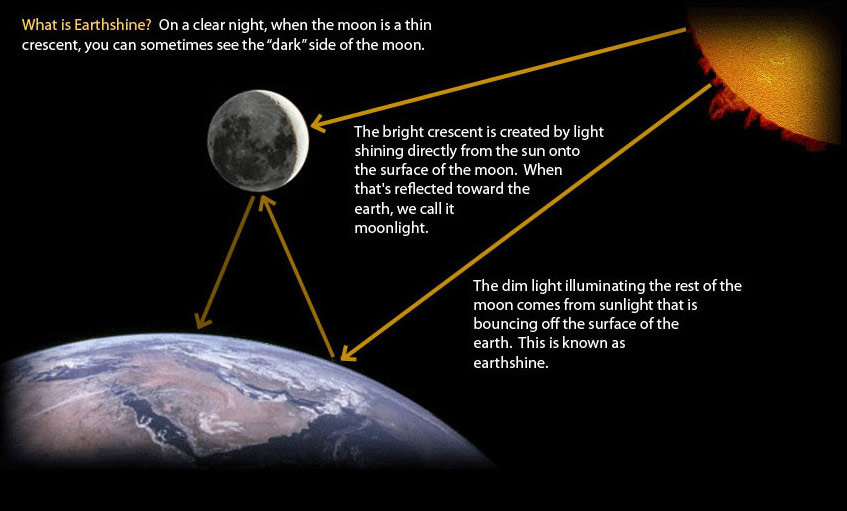In the vast expanse of the cosmos, the quest to explore and comprehend planets existing beyond our solar system—known as extrasolar planets or exoplanets—has become a focal point in contemporary astrophysics. One particularly intriguing phenomenon is the concept of “earthshine,” traditionally referring to the soft illumination of the darkened portion of the Moon, a result of sunlight reflecting off the Earth’s surface. This intriguing optical phenomenon not only provides insight into our own planetary dynamics but also poses a rather playful, yet poignant question: Could the delicate glow of earthshine be harnessed to illuminate the characteristics of distant, extrasolar worlds? As we navigate this inquiry, we encounter both promising opportunities and formidable challenges that beckon further exploration.
The interplay of light between celestial bodies is a cornerstone of astronomical observation. Earthshine occurs when sunlight reflects off Earth’s surface and illuminates the Moon. When viewed from Earth, this subtle glow can reveal details about our planet’s reflective properties, including albedo, which is the measure of reflectivity. The significance of this phenomenon extends beyond mere visual allure; it incites discussions regarding the profiles of distant planets. If Earthshine can provide insights into our own environment, could this reflection mechanism also aid in deducing the characteristics of exoplanets? Such speculations have catalyzed research into the extent to which light emitted or reflected from Earth-like planets can divulge their atmospheric and geological properties.
The potential for using earthshine to glean information about extraterrestrial worlds introduces an unprecedented dimension to the study of astrobiology and planetary science. Light acts as a messenger, carrying intricate data encoded within its spectrum. By analyzing the light spectrum reflected from an exoplanet, scientists can infer a variety of factors, including the composition of the atmosphere, the presence of liquid water, and even biological markers that suggest life. This necessitates advanced observational technologies capable of discerning the faint light signatures from distant planets against the overwhelmingly brilliant backdrop of their parent stars.
Critical in this venture is the technique known as “spectroscopy,” which allows astrophysicists to dissect light into its constituent wavelengths. Through this method, subtle variations in the light spectrum can unveil the chemical makeup of a planet’s atmosphere. For instance, the detection of specific absorption lines can indicate the presence of water vapor, carbon dioxide, or even oxygen—all vital ingredients for fostering life. This methodological application transcends mere theoretical ambition; it represents a tangible pathway toward comprehensively understanding our cosmic neighborhood.
However, despite the tantalizing prospects that earthshine offers, the challenge remains formidable. The primary hurdle is the overwhelming brightness of stars, which can obscure the faint light signals emitted or reflected from orbiting planets. Current technologies such as coronagraphs—which work to block out starlight—have demonstrated efficacy in isolating light from exoplanets, but they are not foolproof. The stars’ luminosity hides intricate details that need to be unmasked through innovative observational techniques.
Moreover, the variability of light conditions in different celestial environments introduces additional complexity. Different exoplanets may exhibit unique light signatures influenced by their atmospheres, surface composition, and proximity to their host stars. For instance, a planet situated near a bright star may emit diluted light signals, obscuring vital information. Contrarily, those with lower luminosities may yield detectable signals, but the lack of energy input could hinder the sustainment of an environment conducive to life.
As the scientific community grapples with these challenges, collaboration among interdisciplinary fields becomes paramount. The merging of astrophysics with atmospheric science, geology, and even bioinformatics can foster a more comprehensive understanding of what constitutes an Earth-like world. This multifaceted approach not only enhances the methodologies to detect and analyze light signals but also amplifies the interpretation of data gathered from distant celestial observations.
Looking ahead, the ongoing development of next-generation telescopes—such as the James Webb Space Telescope—promises to revolutionize our capacity for exoplanet study. These observatories are designed to capture far-infrared radiation, thus expanding the spectral range available for analysis. With improved sensitivity and resolution, it may soon be possible to detect even the faintest traces of earthshine reflecting from distant, rocky exoplanets.
In conclusion, the connection between earthshine and planetary science emerges as a profound exploration into the nuances of astrophysical inquiry. The implications of utilizing natural light—once thought limited to our own Moon—extend to the longing to uncover the mysteries of extrasolar worlds. As we pursue this line of questioning, the interplay of curiosity and scientific rigor holds promise for unlocking the secrets of the universe. Could this delicate dance of light enable us to identify the existence of life elsewhere in the cosmos? While the challenges are formidable, the pursuit itself is inherently rewarding, suggesting that every tiny glimmer in the night sky may be a harbinger of discovery waiting to be unveiled.








